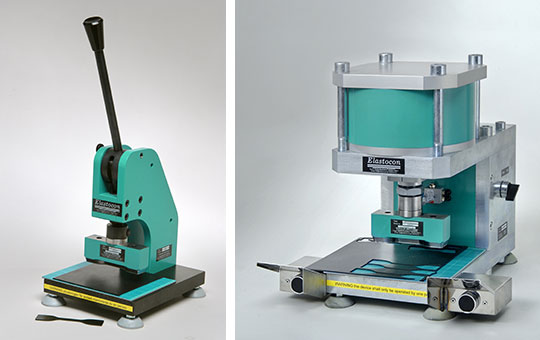The tear strength of a material is a compound property of the force require to initiate a tear in the material and the force required to propagate the tear. Tear tests are performed similarly to common tensile tests for rubber.
Related Standards
ISO 34, ASTM D624
Introduction
The tear strength of a material is a compound property of the force require to initiate a tear in the material and the force required to propagate the tear. By using a ‘universal test machine’ (UTM), commonly called a tensile tester, with a constant speed and the sample bodies in ISO 34 one or both of these properties can be studied. By introducing a pre-cut nick, the propagation tear strength can be isolated. The result is presented in kN/m, that is the force per meter (thickness) required to propagate a tear.
Performance
Tear tests are performed similarly to common tensile tests for rubber. A test piece is punched out from a standard 2 mm thick sample sheet. In some cases the test piece has a small nick cut into it as well. The test piece is then mounted in the UTM, an appropriate method is selected, the thickness of the sample is entered, and the machine does the rest.

Figure 1. Tinius Olsen 5ST, a UTM well suited for tear tests on rubber.
In ISO 34 there are four different test pieces: Trouser, Angle, Crescent and Small (Delft) test pieces. and a nick cutter is used for sample body B (which can be used with or without a pre-cut nick) and sample body C. The precision of the nick is very important to produce accurate results.

Figure 2. ISO 34, Tear test – Trouser test piece (method A), Angle test piece (method B) and Crescent test piece (method C).
The gradual tear of the sample is often less spectacular than a sudden rip from a tensile test. The information gained from this test is related, but not identical to that of a tensile test. Depending on the method used, a fast tear test can be seen as a tensile test with an initiated break. A trouser test is quite slow by contrast and it gives a different type of measurement. One important piece of information can be that of grain effects in a rubber, where the material has insufficient mixing. This is especially obvious in a method A test, which takes significantly longer than the other two. The required force can vary significantly during the test, which makes it obvious why the standard sample size is five samples instead of the three of an ISO 37 tensile test. Small variations in the nicks cut in the test pieces also increase the result spread.
Conclusion
Tear strength testing is readily available to labs equipped to do tensile tests. The only further equipment needed is for sample preparation, in the form of punching dies and nick cutters. The information gained from this test is complementary to that of tensile testing and is relevant for applications where the material will be used in tension. Since some materials have a large difference between tensile strength and tear strength (like paper), both can be important to perform.
Elastocon represents Tinius Olsen in Sweden, Norway and Finland in sales of their line of UTM machines which perform ISO and ASTM compliant tear strength tests. A Tinius Olsen 5ST machine can be seen above.

Figure 3. Elastocon EP 08 Manual Press to the left and EP 02 Pneumatic Press to the right.

Figure 4. A small selection of the EP 04 cutting dies Elastocon produces.
Elastocon also develops, manufactures and sells cutting presses (Elastocon EP 02 and EP 08) and cutting dies (Elastocon EP 04) for all relevant standards, as well as nick cutting jigs (Elastocon EP 07).
Read more about Elastocon's equipment for sample preparation here
For more information, please contact us at This email address is being protected from spambots. You need JavaScript enabled to view it.
And for further reading, please find the referenced standards at:
ISO 34-1:2015: https://www.iso.org/standard/65926.html
ASTM D624: https://www.astm.org/Standards/D624.htm
Abbreviations:
UTM – Universal Testing Machine
Kim Bini


